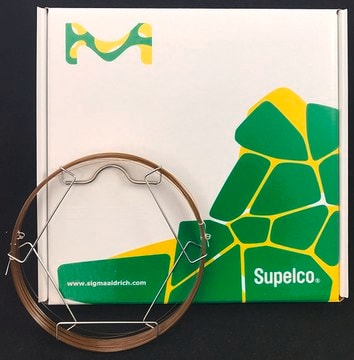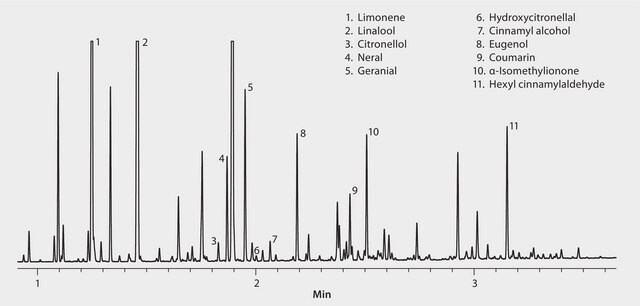28471-U
SLB®-5ms Capillary GC Column
L × I.D. 30 m × 0.25 mm, df 0.25 μm
Recommended Products
material
fused silica
Agency
Standard Method 6040D
EN 2005/108/EC
EPA TO-13,IP-8,8270,525.2,608.1/608.2,608/8081/OLM04.2 PEST,610,625,8015,8082,8100,8141,8270,OLM04.2 SVOA
JMHLW
NIOSH 2530,5503
OSHA 62
meets requirements for USP G27 and G36
reg. compliance
FDA LIB 4423
parameter
-60-340 °C temperature (isothermal)
-60-360 °C temperature (programmed)
Beta value
250
df
0.25 μm
technique(s)
GC/MS: suitable
gas chromatography (GC): suitable
L × I.D.
30 m × 0.25 mm
matrix active group
Bonded and highly crosslinked; silphenylene polymer virtually equivalent in polarity to poly(5% diphenyl/95% dimethyl siloxane) phase
application(s)
agriculture
chemicals and industrial polymers
cleaning products
clinical
cosmetics
environmental
flavors and fragrances
food and beverages
forensics and toxicology
industrial hygiene
life science and biopharma
personal care
petroleum
pharmaceutical (small molecule)
column type
capillary non-polar
Looking for similar products? Visit Product Comparison Guide
Related Categories
General description
USP Code: This column meets USP G27 and G36 requirements.
Phase:
- Bonded and highly crosslinked
- Silphenylene polymer virtually equivalent in polarity to poly(5% diphenyl/95% dimethyl siloxane)
- ≤0.32 mm I.D.: -60 °C to 340 °C (isothermal) or 360 °C (programmed)
- ≥0.53 mm I.D.: -60 °C to 330 °C (isothermal) or 340 °C (programmed)
Other Notes
Legal Information
Certificates of Analysis (COA)
Search for Certificates of Analysis (COA) by entering the products Lot/Batch Number. Lot and Batch Numbers can be found on a product’s label following the words ‘Lot’ or ‘Batch’.
Already Own This Product?
Documents related to the products that you have purchased in the past have been gathered in the Document Library for your convenience.
Difficulty Finding Your Product Or Lot/Batch Number?
How to Find the Product Number
Product numbers are combined with Pack Sizes/Quantity when displayed on the website (example: T1503-25G). Please make sure you enter ONLY the product number in the Product Number field (example: T1503).
Example:
Additional examples:
705578-5MG-PW
PL860-CGA/SHF-1EA
MMYOMAG-74K-13
1000309185
enter as 1.000309185)
Having trouble? Feel free to contact Technical Service for assistance.
How to Find a Lot/Batch Number for COA
Lot and Batch Numbers can be found on a product's label following the words 'Lot' or 'Batch'.
Aldrich Products
For a lot number such as TO09019TO, enter it as 09019TO (without the first two letters 'TO').
For a lot number with a filling-code such as 05427ES-021, enter it as 05427ES (without the filling-code '-021').
For a lot number with a filling-code such as STBB0728K9, enter it as STBB0728 without the filling-code 'K9'.
Not Finding What You Are Looking For?
In some cases, a COA may not be available online. If your search was unable to find the COA you can request one.
Which document(s) contains shelf-life or expiration date information for a given product?
If available for a given product, the recommended re-test date or the expiration date can be found on the Certificate of Analysis.
How do I get lot-specific information or a Certificate of Analysis?
The lot specific COA document can be found by entering the lot number above under the "Documents" section.
How does the SLB™-5ms Capillary GC Column differ from our other 5-type columns?
Many of our other 5-type columns (Equity-5, SPB-5, PTE-5, MDN-5, and MDN-5S) incorporate a siloxane polymer (backbone comprised of Si and O atoms only, side groups are either methyl or phenyl). The SLB-5ms column incorporates a silphenylene polymer (backbone comprised of Si and O atoms plus some phenyl groups, side groups are either methyl or phenyl).
What are the benefits of the SLB™-5ms Capillary GC Column over other manufacturers’ -5ms columns?
The SLB-5ms excels in several performance criteria.· Low Bleed. The highly crosslinked silphenylene polymer chemistry reduces column bleed to a very low level, resulting in greater signal-to-noise level, allowing lower detection levels.· Inertness. The proprietary surface deactivation reduces interactions between analytes and the column surface, resulting in sharper peak shapes, allowing lower detection levels.· Durability. With the highest published maximum allowable operating temperature (MAOT) of any -5ms column, SLB-5ms columns are designed for long life.· Consistency. Innovative manufacturing processes result in decreased column variability, ensuring that the next column is as good as the last.
Would you recommend SLB™-5ms Capillary GC Columns for all applications instead of Equity-5, SPB-5, PTE-5, MDN-5, and MDN-5S?
Yes.
Who uses SLB™-5ms Capillary GC Columns?
Any analyst with the need for a non-polar column. Some applications include boiling point separations, GC-MS analyses of semivolatiles, and GC-ECD analyses of pesticides/PCBs. It is estimated that non-polar columns account for 51% of the worldwide column market.
What if my method does not allow me to change to SLB™-5ms Capillary GC Columns?
These methods typically specify a 5-type column (DB-5 or equivalent). The SLB-5ms satisfies that requirement.
How do I find price and availability?
There are several ways to find pricing and availability for our products. Once you log onto our website, you will find the price and availability displayed on the product detail page. You can contact any of our Customer Sales and Service offices to receive a quote. USA customers: 1-800-325-3010 or view local office numbers.
What is the Department of Transportation shipping information for this product?
Transportation information can be found in Section 14 of the product's (M)SDS.To access the shipping information for this material, use the link on the product detail page for the product.
My question is not addressed here, how can I contact Technical Service for assistance?
Ask a Scientist here.
Articles
Resolving by Mass
GC Analysis of Neroli Essential Oil on SLB®-5ms
Compared to conventional PSA/C18/GCB cleanup, cannabis extracts cleaned with the Supel QuE Verde mixture showed lower GC/MS background, and better recoveries for many pesticides.
Protocols
GC Analysis of PBDE Flame-Retardant Compounds
Separation of null
Extraction and Analysis of PAHs in Olive Oil using Molecularly Imprinted Polymer SPE and GC-MS
The primary column is used to determine presence of the target analytes in the sample; the secondary column of a different selectivity confirms whether a positive match.
Chromatograms
suitable for GCsuitable for GCsuitable for GCapplication for SPE, suitable for GCShow MoreOur team of scientists has experience in all areas of research including Life Science, Material Science, Chemical Synthesis, Chromatography, Analytical and many others.
Contact Technical Service

